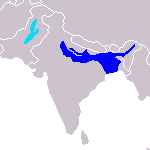Indus dolphin
| Indus dolphin | ||||||||||||
|---|---|---|---|---|---|---|---|---|---|---|---|---|

Cast of an Indus dolphin skull in the Indianapolis Children's Museum |
||||||||||||
| Systematics | ||||||||||||
|
||||||||||||
| Scientific name | ||||||||||||
| Platanista minor | ||||||||||||
| Owen , 1853 |
The Indus dolphin ( Platanista minor ) is a very rare toothed whale species that is endemic to the Indus and its tributaries . The remaining slightly more than 1000 animals live in three populations separated from one another by dams. Today's distribution area extends over 700 km and thus only comprises around 20% of the original distribution area. In 1970 the species was placed under protection in Pakistan .
features
The Indus dolphin is a maximum of 2.5 meters long and can reach a weight of 90 kg. Females are larger and have a longer snout. The head profile is steep and rounded due to the eye-catching melon . On the melon there is an elongated, uneven comb with the elongated, slit-like blowhole on the side of the rear end . The eyes above the corners of the mouth are barely developed and tiny. The snout is gavial-like long and very slender. The front, bulbous thickened part is covered with numerous, elongated and sharp teeth. The neck of the animals is unusually flexible and movable for whales. The back is flat and wide. On its rear section lies the flat, triangular fin , which ends in a low ridge that extends down to the broad fluke . The fluke is concave at the back and has long, pointed ends. The flippers are wide and paddle-like. Their rear edges are flat or wavy, creating a finger-like impression.
Indus dolphins are colored olive yellow, olive brown, gray brown or gray blue. The ventral side is lighter, often pink. Young animals are colored uniformly gray.
Surface behavior
The Indus dolphin lives alone or in pairs. He usually swims slowly and rarely jumps. However, jumps are noticeable due to the loud splash. The fluke is rarely visible. Dives last between 30 seconds and several minutes. The echolocation clicks it emits for orientation and foraging sound like sneezing above the water surface. Often he swims lying on one side. He is shy of people.
Systematics
The Indus dolphin was originally considered a subspecies of the Ganges dolphin , from which it does not differ externally. Today, however, it is listed in the Mammal Species of the World database . managed as a separate species.
literature
- Hadoram Shirihai : marine mammals. All 129 species worldwide. Illustrated by Brett Jarett. Franckh-Kosmos Verlags GmbH, Stuttgart 2008, ISBN 978-3-440-11277-9 .
Web links
- Don E. Wilson & DeeAnn M. Reeder (Eds.): Platanista minor in Mammal Species of the World. A Taxonomic and Geographic Reference (3rd ed).
- Platanista gangetica ssp. minor in the endangered Red List species the IUCN 2008. Posted by: Braulik, GT, Smith, BD & Chaudhry, AA (Cetacean Specialist Group), 2004. Accessed April 25, 2012th
